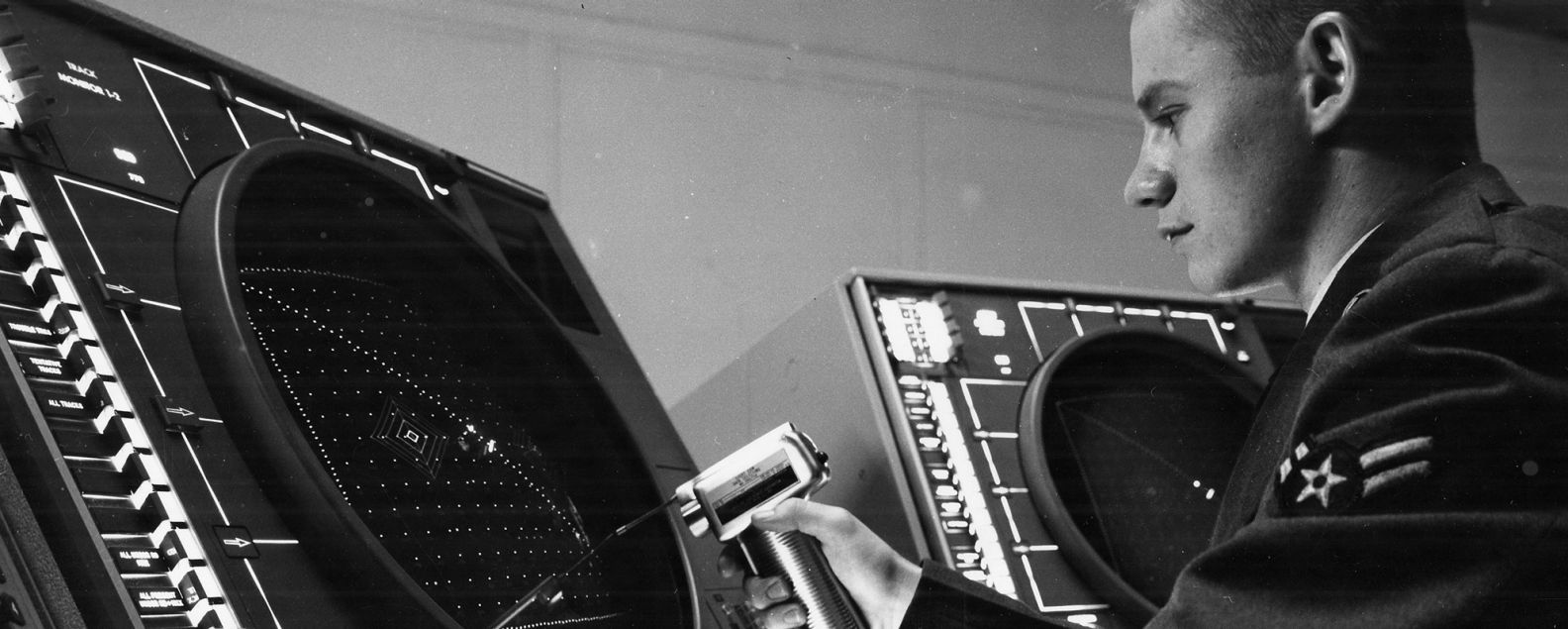About cookies on this site Our websites require some cookies to function properly (required). In addition, other cookies may be used with your consent to analyze site usage, improve the user experience and for advertising. For more information, please review your options. By visiting our website, you agree to our processing of information as described in IBM’sprivacy statement. To provide a smooth navigation, your cookie preferences will be shared across the IBM web domains listed here.
SAGE
An atomic bomb kicked off the biggest computing project in history — and cemented IBM’s leadership role in a new class of online systems

When the Soviet Union detonated its first atomic bomb, in 1949, it triggered the US government to call on the Massachusetts Institute of Technology (MIT) to create a real-time, state-of-the-art air defense system covering the entirety of North America. Much like modern-day air traffic control scans the skies, the system would need to observe for incoming airborne threats, evaluate them, and coordinate data to produce a unified image of the airspace. Pulling off such a feat would require developing many technologies that didn’t yet exist.
The result was the world’s largest computer project at the time and perhaps the most ambitious computing project in history. Called SAGE, for Semi-Automatic Ground Environment, it brought together some of the most innovative US entities under the aegis of MIT’s Lincoln Laboratories, which would manage system integration. IBM handled hardware development and manufacturing; Burroughs oversaw inter-site communications; Western Electric contributed building construction; and SDC (part of the RAND Corporation) delivered software.
The project would become crucially important to IBM’s bottom line during the 1950s and provide a foothold into future computing endeavors. Between 1952 and 1955, 80% of the company’s computing revenue came from SAGE, and the system spun off several technological innovations, including the automated flight reservation system known as Sabre. SAGE established IBM as a leader in a new class of online computing and attracted the interest of other government agencies and industry alike.
In addition to being vital for national security, SAGE was a proving ground for the US Department of Defense. It demonstrated the government’s ability to coordinate large-scale, diversified and highly sophisticated computer research and development.
From his earliest conversations with MIT, IBM vice president of engineering John McPherson, who would become the company’s point person on SAGE, quickly recognized the magnitude of the data processing opportunity — the largest for IBM since it was contracted to develop the accounting and tracking system for the Social Security Administration in the mid-1930s. Thomas Watson Jr., IBM’s president at the time, agreed. “I worked harder to win that contract than I worked for any other sale in my life,” he would recall in his memoir.
IBM won the rights to build the computer at the heart of the digital system, known as the AN/FSQ-7, because of the company’s “much higher degree of purposefulness, integration and esprit de corps,” according to MIT project leader Jay W. Forrester, and closer ties among research, factory and field maintenance. About 300 full-time IBMers were assigned to SAGE by the end of 1953, primarily in the company’s Poughkeepsie and Kingston, New York, facilities, and in MIT’s hometown of Cambridge, Massachusetts.
When the AN/FSQ-7 prototype was unveiled in 1956, it provided military commanders a view of an air battle and demonstrated the ability to automatically calculate the most effective use of missiles and aircraft to fend off attack. By 1958, more than 7,000 IBMers were involved in the project, including engineers, sales staff and senior management, as well as the technical liaisons who collaborated with academics and military personnel on installation, operation and maintenance.
When fully deployed in 1963, SAGE included multiple redundancies to allow downtime-free maintenance. The system was deployed across 27 North American centers, each with its own AN/FSQ-7 system that comprised two fully functional machines, one of which served as a backup. The total cost of SAGE is commonly estimated to have been around USD 8 billion, including 56 IBM computers at USD 30 million each. The AN/FSQ-7 system weighed 250 tons and occupied an acre of floor space.
SAGE incorporated new technologies and methods that provided the foundation for advances in computation for years to come. Among them: magnetic core memories, which worked faster and held more data than earlier technologies; the first real-time operating system; highly disciplined programming methods; overlapping computing and I/O operations; real-time transmission of data over telephone lines; the first use of CRT terminals and light pens; and novel redundancy and backup methods and components. SAGE also had the highest reliability of any computer system at the time.
SAGE also produced an array of inventions in data processing and communications hardware used across a new distributed system of real-time information, now known as a network. When fully deployed, SAGE operated across 27 locations via modems and 25,000 telephone lines (using digital-analog and analog-digital conversions). The system displayed novel interactive computer graphics, often executed by a light gun aimed at a screen. Ultimately, 54 systems were installed, all coordinating with one another.
Ultimately, SAGE became a platform for a series of groundbreaking IBM products: the IBM 704, which improved upon the magnetic core memory in SAGE; tape storage; Fortran, the first commercial high-level computer programming language; and the IBM System/360.
SAGE remained in service by the US government until January 1984, when it was replaced with a next-generation air defense network. SAGE became an icon of its day partly due to its enormous size, impressive power (for the time), and for its role in the Cold War. The system’s components were often used in television and film, including cameo appearances on Battlestar Galactica in the 1970s and Lost in the 2000s, helping to memorialize SAGE as a symbol of how technology safeguarded the world.